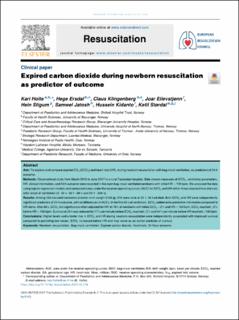| dc.description.abstract | Aim To explore and compare expired CO2 (ECO2) and heart rate (HR), during newborn resuscitation with bag-mask ventilation, as predictors of 24-h outcome. Methods Observational study from March 2013 to June 2017 in a rural Tanzanian hospital. Side-stream measures of ECO2, ventilation parameters, HR, clinical information, and 24-h outcome were recorded in live born bag-mask ventilated newborns with initial HR < 120 bpm. We analysed the data using logistic regression models and compared areas under the receiver operating curves (AUC) for ECO2 and HR within three selected time intervals after onset of ventilation (0–30 s, 30.1–60 s and 60.1–300 s). Results Among 434 included newborns (median birth weight 3100 g), 378 were alive at 24 h, 56 had died. Both ECO2 and HR were independently significant predictors of 24-h outcome, with no differences in AUCs. In the first 60 s of ventilation, ECO2 added extra predictive information compared to HR alone. After 60 s, ECO2 lost significance when adjusted for HR. In 70% of newborns with initial ECO2 <2% and HR < 100 bpm, ECO2 reached ≥2% before HR ≥ 100 bpm. Survival at 24 h was reduced by 17% per minute before ECO2 reached ≥2% and 44% per minute before HR reached ≥100 bpm. Conclusions Higher levels and a faster rise in ECO2 and HR during newborn resuscitation were independently associated with improved survival compared to persisting low values. ECO2 increased before HR and may serve as an earlier predictor of survival.
Abbreviations AUC area under the receiver operating curves, BMV bag-mask ventilation, BW birth weight, bpm beats per minute, ECO2 expired carbon dioxide, GA gestational age, HR heart rate, Mbar millibar, ROC receiver operating characteristics, VTE expired tidal volume. | en_US |

